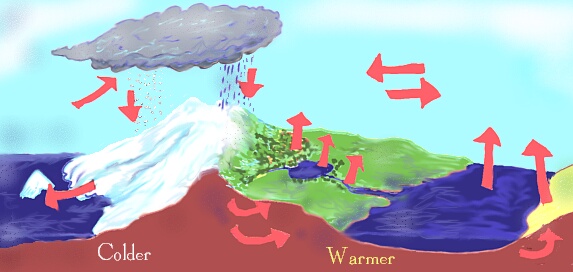
| Some 97 per cent of the world's distributive water is in the oceans. This is about 1,322,000,000 (97.2%) cubic kilometres of water. Ice caps and glaciers hold about 29,200,000 cubic kilometres (2.15%), 8,637,000 cubic kilometres (0.625%) are within the ground, 230,250 cubic kilometres (0.017%) are in rivers and lakes. The remaining balance of 108,350 cubic kilometres (0.008%) of the world's water is contained in the soil, the atmosphere and the biosphere, and is most vital for life. More than 75 per cent of water on land is frozen in ice sheets and glaciers (e.g. Greenland and Antarctica. About 22 percent of land water is ground water below the earth's surface. So, actually, only small amounts are in lakes, rivers and soil. Water in the soil for plants is called capillary water. Molecular attraction between the water and soil particles keeps it a few years within the ground surface. |
| The water cycle comes about through the heat of the sun and gravity. The sun´s heat causes evaporation over the oceans, which cover about 71 per cent of the earth's surface. Water vapour rises on aircurrents and winds. Some will drop as rain directly to the oceans but other gets dropped as rain or snow over land (precipitation). A proportion is then evaporated again by the sun. Some rain and melted snow seeps through the soil into the rocks beneath to form ground water. Some just gets into the ground where plants absorb it and in part send it back into the air by transpiration. |
| Some water flows over the land as runoff, which collects into rills, then streams and then rivers. Where colder, in polar and high mountainous regions, most precipitation is snow. It gets compacted into ice sheets and glaciers. Gravity pulls this ice downwards and outwards. If they get to the oceans chunks breaking off at the coastline can create icebergs. |
| Thus all the water that does not return directly to the atmosphere gradually returns to the sea to complete the water cycle. The Study of this hydrologic or water cycle which then goes on to examine the distribution of water and its use by humankind is called hydrology. |

| Plan showing two seas, a landmass, cold at one side and warmer at the other, and a desert (far right). |
Cyclical flows:
- Moist air from the oceans
- Moist air to the oceans
- Precipitation as rain
- Evaporation of falling and fallen rain
- Surface run off
- Ground water into streams and rivers
- Ground water into the ocean
- Transpiration by plants
- Evaporation from streams and rivers
- Evaporation from lakes
- Evaporation from soil
- Rivers flow into oceans
- Evaporation from oceans
- Ocean to arid land by ground water flow
- Strong evaporation from arid land
- Precipitation as snow
- Ice movement towards the ocean
| Ground water is a key water storage system. It enters permeable rocks through the zone of intermittent saturation. It is a temporary area of saturation only with rain. Below this the pores or crevices fill with water in the zone of saturation within 100 feet of the surface, and continues down until meeting impermeable rock which is the ground water dam. It is the top of the saturated zone that is called the water table which obviously varies with rainfall, but less obvious is that it isn't actually level. It is arched under hills, and close to the surface on level plains. Where the water table comes above ground level, it forms swamps, lakes, oases (deserts) and, at the foot of hills, springs. A stream below the water table is known as a gaining stream whereas a stream above the water table is known as a losing stream. Another reason for springs occuring is impermeable rock. |
| The lowest level of the water table, when dryest, is the permanent water table. This is the depth wells must reach for all year round water supply. If the rim of the well is below the level of the water table in the catchment area then water is forced to the surface by hydrostatic pressure. This is called an Artesian well. |
| Otherwise there is spring water. This water is usually fresh and clean because it filtrates through rock pores. Limestone is not porous but it is permeable (it has fissures, joints and eaves). Therefore there is not the same filtration and the water can be unhealthy. Some springs are said to be healthy because mineral substances are contained in solution. Sometimes these springs are thermal. |
| Oceanic water is not suitable for drinking or farming. It is salty. Of course seawater can be desalinated to make fresh water, as near deserts. |
Adrian Worsfold